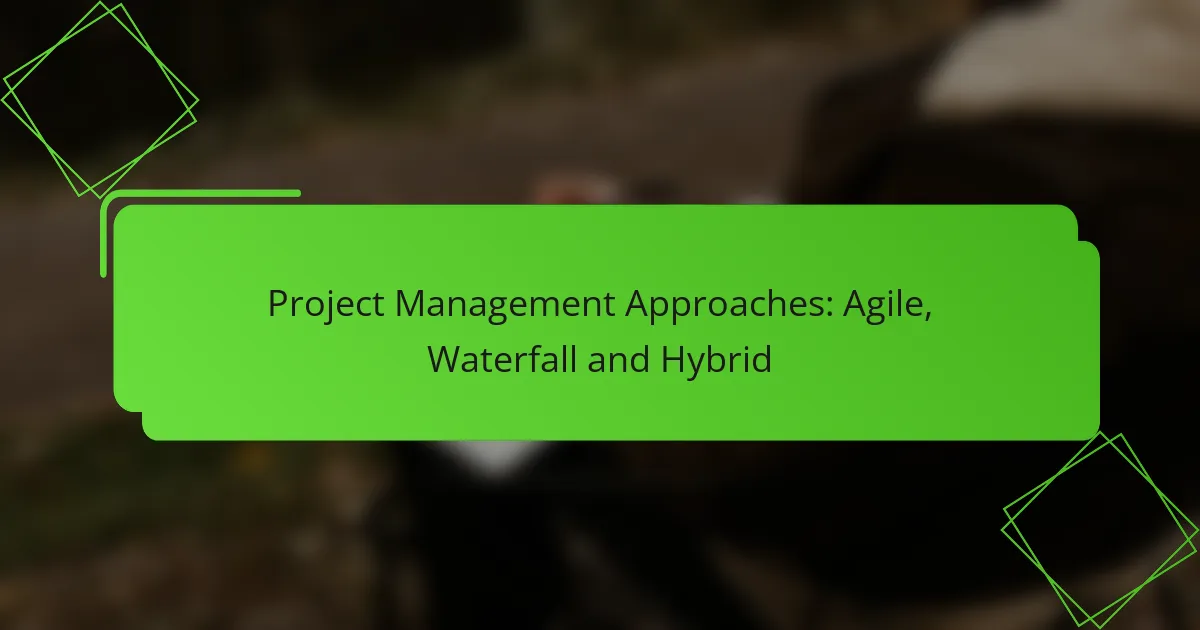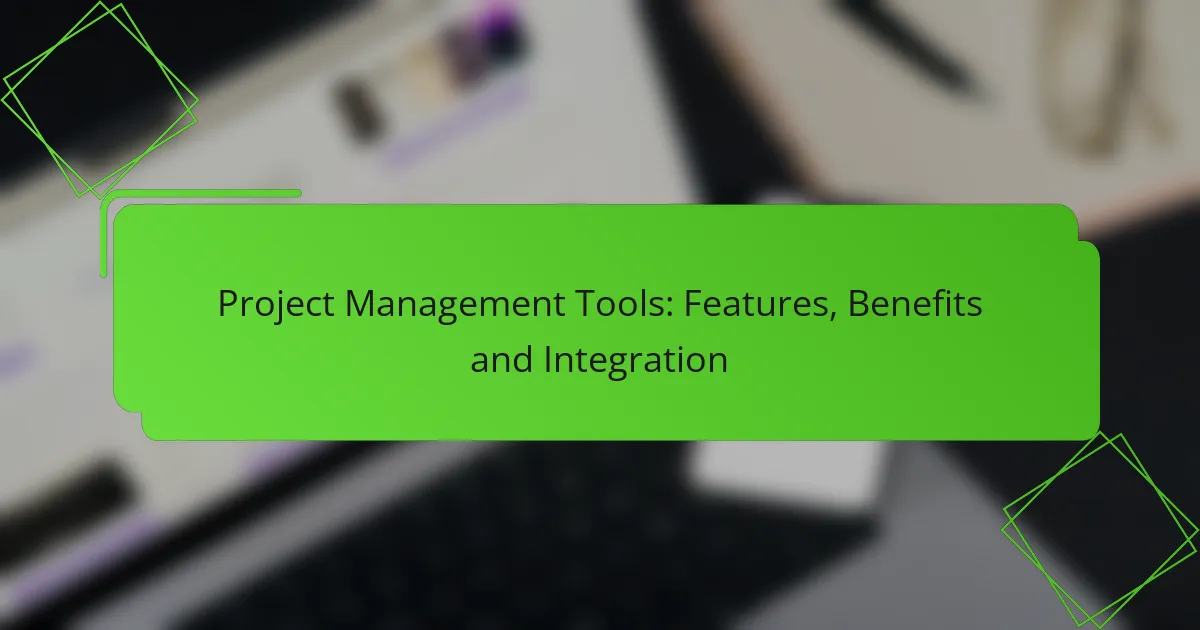Project management approaches such as Agile, Waterfall, and Hybrid offer distinct methodologies tailored to various organizational needs and project types. Agile emphasizes flexibility and iterative progress, while Waterfall follows a structured, linear process. Understanding these approaches can help businesses in Ireland choose the most effective strategy for their projects.

What are the best project management approaches for businesses in Ireland?
The best project management approaches for businesses in Ireland include Agile, Waterfall, and Hybrid methodologies. Each approach has distinct characteristics that can suit different project types and organizational needs.
Agile methodology
Agile methodology focuses on iterative development and flexibility, allowing teams to adapt to changes quickly. It is particularly effective for projects where requirements evolve over time, such as software development.
Key practices include regular stand-up meetings, sprints, and continuous feedback from stakeholders. Businesses in Ireland often use Agile to enhance collaboration and improve product quality, making it suitable for tech startups and innovative projects.
Waterfall methodology
Waterfall methodology is a linear and sequential approach, where each project phase must be completed before the next begins. This method is best suited for projects with well-defined requirements and minimal expected changes, such as construction or manufacturing.
In Ireland, companies may prefer Waterfall for projects that require strict adherence to regulations and timelines. However, it can be inflexible, so it’s crucial to ensure that all requirements are thoroughly understood before starting.
Hybrid approach
The Hybrid approach combines elements of both Agile and Waterfall methodologies, allowing teams to benefit from the structure of Waterfall while maintaining the flexibility of Agile. This approach is ideal for projects that have both stable and evolving components.
In Ireland, businesses might adopt a Hybrid model to manage complex projects that require regulatory compliance alongside innovative development. It’s important to clearly define which parts of the project will follow Agile practices and which will adhere to Waterfall to avoid confusion.
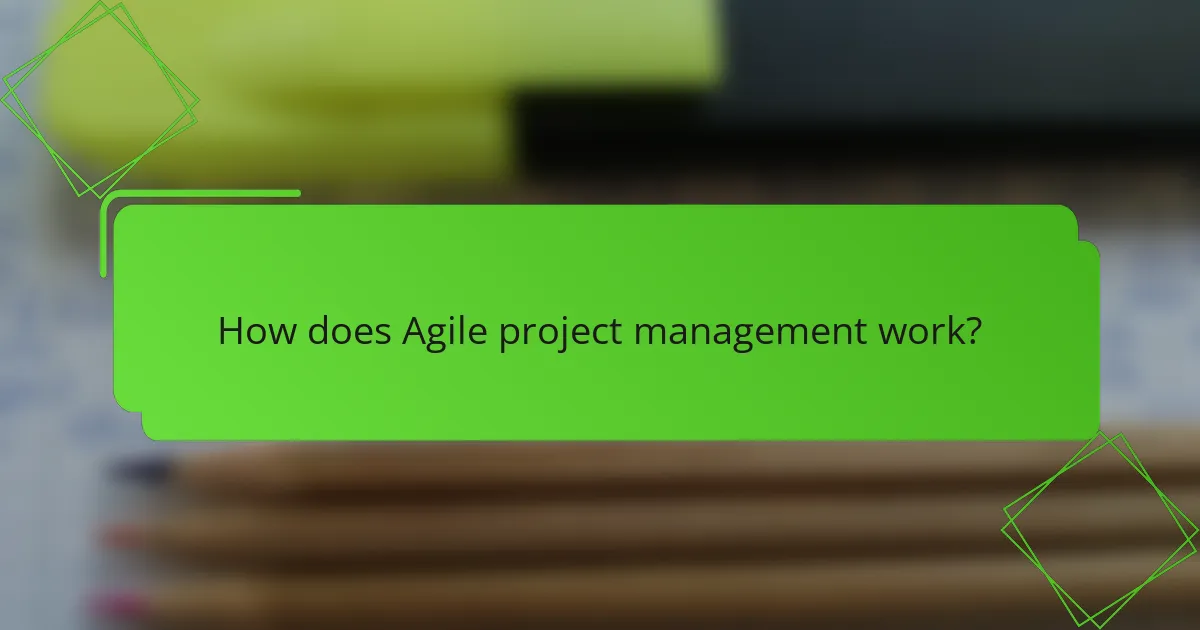
How does Agile project management work?
Agile project management focuses on flexibility and iterative progress through small, incremental changes. It emphasizes collaboration, customer feedback, and adapting to change rather than following a fixed plan.
Iterative development
Iterative development is a core principle of Agile, where projects are broken down into smaller segments called iterations or sprints. Each iteration typically lasts from one to four weeks, allowing teams to deliver functional components of the project regularly.
This approach enables teams to assess progress frequently and make necessary adjustments based on feedback. For example, if a feature is not meeting user expectations, it can be modified in the next iteration without derailing the entire project.
Customer collaboration
Customer collaboration is essential in Agile, as it involves continuous engagement with stakeholders throughout the project lifecycle. Regular meetings, such as sprint reviews, ensure that customer feedback is incorporated into the development process.
By involving customers early and often, teams can better understand their needs and preferences, leading to a final product that aligns closely with expectations. This collaboration can significantly reduce the risk of costly changes late in the project, enhancing overall satisfaction.
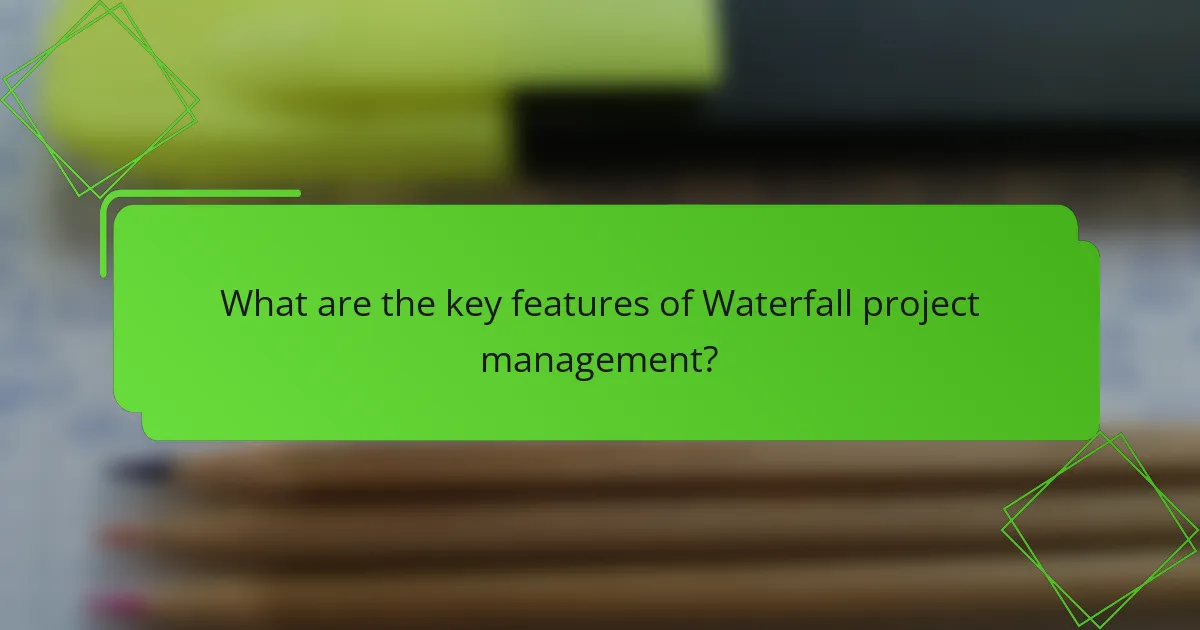
What are the key features of Waterfall project management?
Waterfall project management is a linear and sequential approach where each phase must be completed before the next one begins. This method is characterized by its structured process, making it easier to manage and predict project timelines and deliverables.
Sequential phases
The Waterfall model consists of distinct sequential phases: requirements, design, implementation, verification, and maintenance. Each phase has specific deliverables and milestones, ensuring that the project progresses in a controlled manner. For example, once the requirements are gathered and documented, the design phase begins, which cannot be revisited without significant implications.
This sequential nature allows for clear tracking of progress and accountability, but it can also lead to challenges if changes are needed after a phase is completed. Teams should be cautious about rigid adherence to the timeline, as unforeseen issues may arise that require revisiting earlier phases.
Fixed requirements
In Waterfall project management, requirements are typically defined at the beginning of the project and remain fixed throughout its lifecycle. This clarity helps in planning and resource allocation, as all stakeholders have a clear understanding of what is expected. However, this rigidity can be a drawback if project needs evolve over time.
To mitigate risks associated with fixed requirements, it’s advisable to conduct thorough initial requirement gathering and validation. Engaging stakeholders early and often can help ensure that the requirements are comprehensive and accurately reflect the project’s goals. Teams should also prepare for potential change requests, which can disrupt the flow and increase costs if not managed properly.

When should you choose a Hybrid project management approach?
A Hybrid project management approach is ideal when a project has both stable and dynamic elements, allowing teams to adapt to changing requirements while maintaining a structured framework. This method is particularly useful for complex projects that require a balance between flexibility and predictability.
Complex project requirements
Hybrid project management is well-suited for projects with complex requirements that cannot be fully addressed by either Agile or Waterfall alone. For instance, if a project involves multiple stakeholders with varying needs, a Hybrid approach allows teams to incorporate feedback and adjust plans while adhering to essential timelines and deliverables.
Consider using a Hybrid model when dealing with projects that have regulatory constraints or fixed deadlines, as it enables teams to follow a structured path while remaining responsive to changes. This flexibility can help mitigate risks associated with unforeseen challenges.
Combining flexibility and structure
The Hybrid approach merges the best of both Agile and Waterfall methodologies, providing a framework that supports iterative development alongside a clear project timeline. This combination allows teams to prioritize tasks and make adjustments based on ongoing feedback while ensuring that critical milestones are met.
When implementing a Hybrid model, establish clear phases for planning and execution. For example, you might start with a Waterfall phase for initial planning and requirements gathering, followed by Agile sprints for development and testing. This structure helps maintain focus while allowing for adaptability in response to project evolution.
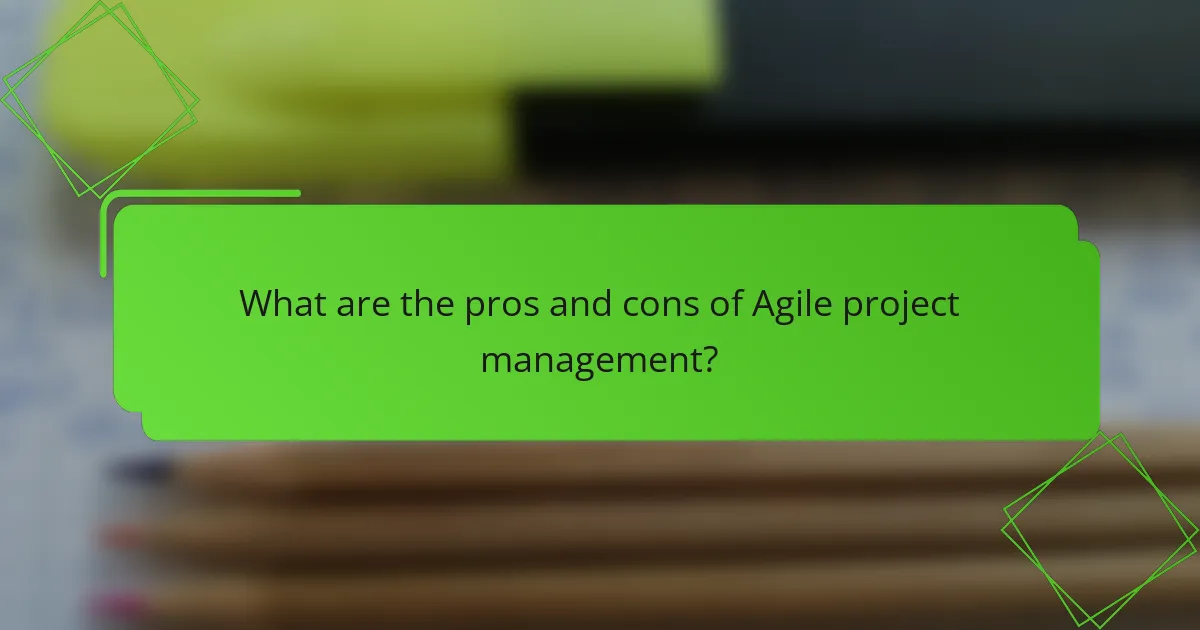
What are the pros and cons of Agile project management?
Agile project management offers flexibility and responsiveness to change, making it suitable for dynamic environments. However, it can also lead to challenges such as scope creep if not managed properly.
Increased adaptability
Agile methodologies prioritize iterative progress and regular feedback, allowing teams to adjust their approach based on stakeholder input and changing requirements. This adaptability is particularly beneficial in industries like software development, where user needs may evolve rapidly.
Teams can implement short development cycles, known as sprints, typically lasting from one to four weeks. This enables quick releases and the ability to pivot based on real-time data and user feedback, enhancing overall project alignment with business goals.
Potential for scope creep
While Agile’s flexibility is an advantage, it can also lead to scope creep, where project requirements expand beyond the original plan. This often occurs when stakeholders continuously add features or changes without proper evaluation of their impact on timelines and resources.
To mitigate scope creep, it’s essential to establish clear project goals and maintain a prioritized backlog. Regular reviews and stakeholder engagement can help ensure that any changes are necessary and manageable, keeping the project on track and within budget.
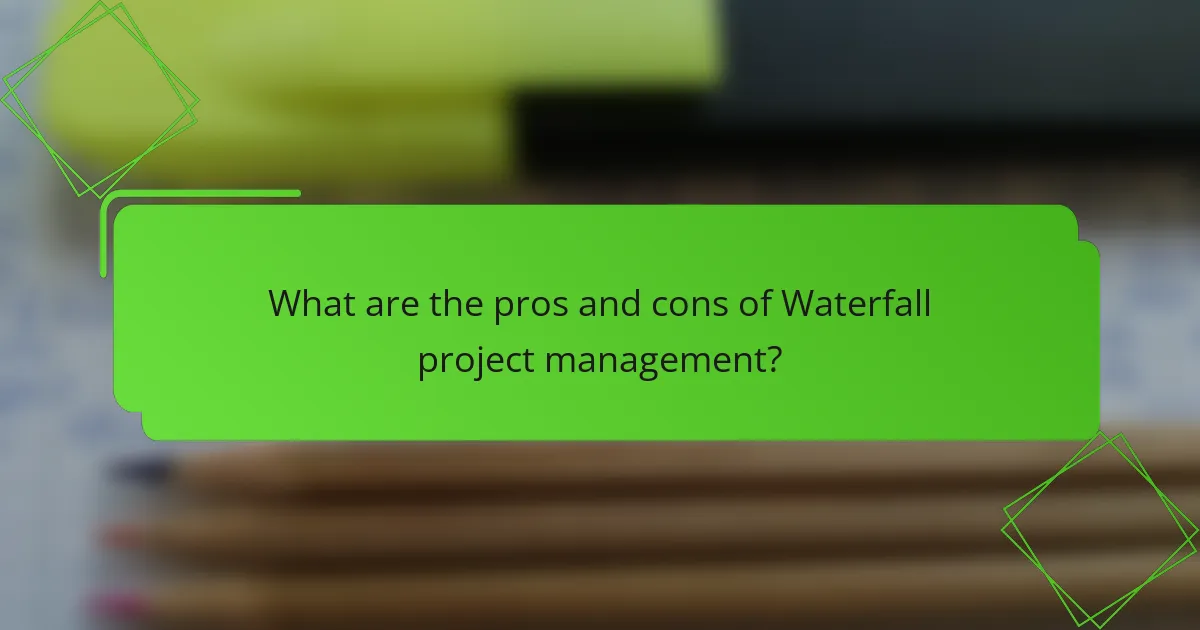
What are the pros and cons of Waterfall project management?
Waterfall project management is a linear approach that offers structured phases, making it easy to follow and manage. However, its rigidity can lead to challenges when adapting to changes during the project lifecycle.
Clear timelines
One of the main advantages of Waterfall project management is its clear timelines. Each phase has defined start and end dates, allowing teams to plan resources and track progress effectively. This clarity helps stakeholders understand when to expect deliverables, fostering accountability.
For example, in a software development project, the requirements phase might take two months, followed by design for another month, and so on. This sequential approach can be beneficial for projects with fixed deadlines or regulatory requirements.
Limited flexibility
While Waterfall provides structure, it is often criticized for its limited flexibility. Once a phase is completed, going back to make changes can be costly and time-consuming. This rigidity can hinder responsiveness to new information or shifting project needs.
For instance, if a client requests a significant change after the design phase, the project may face delays and increased costs as the team revisits earlier stages. Therefore, it’s crucial to ensure that requirements are thoroughly vetted before moving forward to avoid pitfalls associated with this inflexibility.
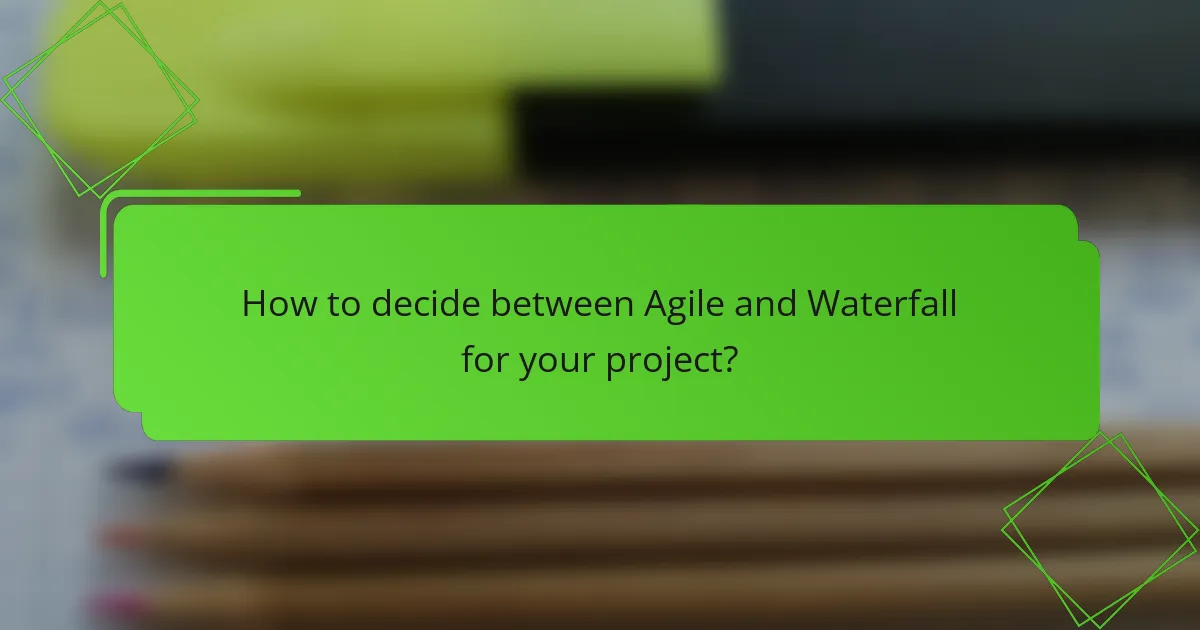
How to decide between Agile and Waterfall for your project?
Choosing between Agile and Waterfall depends on your project’s requirements, timeline, and flexibility needs. Agile is ideal for projects that require adaptability and frequent changes, while Waterfall suits projects with well-defined stages and stable requirements.
Project size and complexity
The size and complexity of your project significantly influence the choice between Agile and Waterfall. For smaller projects with straightforward tasks, Agile can facilitate rapid iterations and quick feedback. Conversely, larger projects with multiple interdependent components may benefit from the structured approach of Waterfall.
Consider the number of stakeholders involved and the potential for changes during the project lifecycle. If your project is likely to evolve, Agile’s flexibility can help manage complexity more effectively.
Team experience
The experience level of your team is crucial in deciding between Agile and Waterfall. Teams familiar with Agile methodologies can leverage its iterative nature to enhance collaboration and responsiveness. If your team has a strong background in traditional project management, they may find Waterfall’s linear approach more comfortable.
Assess your team’s ability to adapt to new processes. If they are open to learning and experimenting, Agile could lead to innovative solutions. However, if your team prefers a clear roadmap, Waterfall might be the better choice.
